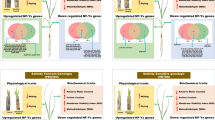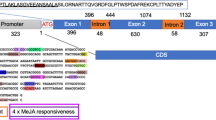Abstract
We report on the isolation and characterization of several genes responsive to wounding in the tropical endangered tree Aquilaria malaccensis. Wounding triggers the formation of a fragrant substance inside the tree stem. Deduced amino acid of the cloned sequences exhibited sequence similarities to their respective homologs: transcription factors of the WRKY gene family (AmWRKY) and β-1,3-glucanase (AmGLU). A homolog to phenylalanine ammonia-lyase (AmPAL) from previous work was also included. All cDNA sequences were of partial lengths. We studied their expression profiles in a wounding-stress experiment. Mechanical wounding induces AmWRKY in an early response to wounding (3 h), and elevates AmPAL and AmGLU expressions after 16 h. It is possible that AmWRKY mediates early wounding response while AmPAL mediates response to fungal infection by co-inducing AmGLU. Their homologs in other plants are known to inhibit fungal growth. Our data provide the first insight into the mechanisms of wounding responses in Aquilaria.





Similar content being viewed by others
Abbreviations
- GOI:
-
Gene of interest
- GOInorm :
-
Normalized gene of interest
- PR:
-
Pathogenesis-related
- qRT-PCR:
-
Quantitative reverse transcription-PCR
- RT:
-
Reverse transcription
- RT-PCR:
-
Reverse transcription-PCR
References
Bailey BA, Strem MD, Bae H, Antuniez de Mayolo G, Guiltinan MJ (2005) Gene expression in leaves of Theobroma cacao in response to mechanical wounding, ethylene, and/or methyl jasmonate. Plant Science 168:1247–1258
Barden A, Anak NA, Mulliken T, Song M (2000) Heart of the matter: agarwood use and trade and CITES implementation for Aquilaria malaccensis. Cambridge, Traffic International
Bonaventure G, Baldwin IT (2010) New insights into the early biochemical activation of jasmonic acid biosynthesis in leaves. Plant Signal Behav 5:287–289
Borrone JW, Kuhn DN, Schnell RJ (2004) Isolation, characterization, and development of WRKY genes as useful genetic markers in Theobroma cacao. Theor Appl Genet 109:495–507
Campos R, Nonogaki H, Suslow T, Saltveit ME (2004) Isolation and characterizationof a wound inducible phenylalanine ammonia-lyase gene (LsPAL1) from Romaine lettuce leaves. Physiol Plant 121:429–438
Chen L, Zhang L, Yu D (2010) Wounding-induced WRKY8 is involved in basal defense in Arabidopsis. Mol Plant-Microbe Interact 23:558–565
Davies KM, Schwinn KE (2003) Transcriptional regulation of secondary metabolism. Funct Plant Biol 30:913–925
Donzelli BGG, Lorito M, Scala F, Harman GE (2001) Cloning, sequence and structure of a gene encoding an antifungal glucan 1,3-β-glucosidase from Trichoderma atroviride (T. harzianum). Gene 277:199–208
Eulgem T, Somssich IE (2007) Networks of WRKY transcription factors in defense signaling. Curr Opin Plant Biol 10:366–371
Eulgem T, Rushton PJ, Robatzek S, Somssich IE (2000) The WRKY superfamily of plant transcription factors. Trends Plant Sci 5:199–206
Graham MY, Weidner J, Wheeler K, Pelow MJ, Graham TL (2003) Induced expression of pathogenesis-related protein genes in soybean by wounding and the Phytophthora sojae cell wall glucan elicitor. Physiol Mol Plant Pathol 63:141–149
Ito M, Honda G (2005) Taxonomical identification of agarwood-producing species. Nat Med 59:104–112
Jin W, Horner HT, Palmer RG, Shoemaker RC (1999) Analysis and mapping of gene families encoding ß-1,3-glucanases of soybean. Genetics 153:445–452
Jones JDG, Dunsmuir P, Bedbrook J (1985) High level expression of introduced chimaeric genes in regenerated transformed plants. EMBO J 4:2411–2418
Kenmotsu Y, Yamamura Y, Ogita S, Katoh Y, Kurosaki F (2010) Transcriptional activation of putative calmodulin genes Am-cam-1 and Am-cam-2 from Aquilaria microcarpa, in response to externals stimuli. Biol Pharm Bull 33:1911–1914
Kenmotsu Y, Ogita S, Katoh Y, Yamamura Y, Takao Y, Tatsuo Y, Fujino H, Kadota S, Kurosaki F (2011) Methyl jasmonate-induced enhancement of expression activity of Am-FaPS-1, a putative farnesyl diphosphate synthase gene from Aquilaria microcarpa. J Nat Med 65:194–197
Kombrink E, Somssich IE (1997) Pathogenesis-related proteins and plant defense. In: Carroll G, Tudzynski P (eds) The Mycota Part A, plant relationships. Springer, Berlin, pp 107–128
Kostenyuk IA, Zoń J, Burns JK (2002) Phenylalanine ammonia lyase gene expression during abscission in citrus. Physiol Plant 116:106–112
Kumeta Y, Ito M (2010) Characterization of δ-guaiene synthases from cultured cells of Aquilaria, responsible for the formation of the sesquiterpenes in agarwood. Plant Physiol 154:1998–2007
Lippok B, Birkenbihl RP, Rivory G, Brümmer J, Schmelzer E, Logemann E, Somssich IE (2007) Expression of AtWRKY33 encoding a pathogen-or PAMP-responsive WRKY transcription factor is regulated by a composite DNA motif containing W Box elements. Mol Plant-Microbe Interact 20:420–429
Liu B, Xue X, Cui S, Zhang X, Han Q, Zhu L, Liang X, Wang X, Huang L, Chen X, Kang Z (2010) Cloning and characterization of a wheat β-1,3-glucanase gene induced by the stripe rust pathogen Puccinia striiformis f. sp. Tritici. Mol Biol Rep 37:1045–1052
Marchive C, Mzid R, Deluc L, Barrieu F, Pirrello J, Gauthier A, Corio-Costet M, Regad F, Cailleteau B, Hamdi S, Lauvergeat V (2007) Isolation and characterization of a Vitis vinifera transcription factor, VvWRKY1, and its effect on responses to fungal pathogens in transgenic tobacco plants. J Exp Bot 58:1999–2010
Matsui T, Bhowmik PK, Yokozeki K (2004) A cDNA sequence encoding Actin gene in moso bamboo shoot and its phylogenetic analysis. Asian J Plant Sci 3:128–131
Mohamed R, Jong PL, Zali MS (2010) Fungal diversity in wounded stems of Aquilaria malaccensis. Fungal Divers 43:67–74
Naef R (2011) The volatile and semi-volatile constituents of agarwood, the infected heartwood of Aquilaria species: a review. Flavour Fragr J 26:73–87
Nishiuchi T, Shinshi H, Suzuki K (2004) Rapid and transient activation of transcription of the ERF3 gene by wounding in tobacco leaves - Possible involvement of NtWRKYs and autorepression. J Biol Chem 279:55355–55361
Okudera Y, Ito M (2009) Production of agarwood fragrant constituents in Aquilaria calli and cell suspension cultures. Plant Biotechnol 26:307–315
Reymond P, Weber H, Damond M, Farmer EE (2000) Differential gene expression in response to mechanical wounding and insect feeding in Arabidopsis. Plant Cell 12:707–720
Riviere MP, Marais A, Ponchet M, Willats W, Galiana E (2008) Silencing of acidic pathogenesis-related PR-1 genes increases extracellular β-1-3,-glucanase activity at the onset of tobacco defence reactions. J Exp Bot 59:1225–1239
Skibbe M, Qu N, Galis I, Baldwin IT (2008) Induced plant defences in the natural environment: Nicotiana attenuata WRKY3 and WRKY6 coordinate responses to herbivory. Plant Cell 20:1984–2000
Sridevi G, Parameswari C, Sabapathi N, Raghupathy V, Veluthambi K (2008) Combined expression of chitinase and β-1,3-glucanase genes in indica rice (Oryza sativa L.) enhances resistance against Rhizoctonia solani. Plant Science 175:283–290
Subehan UJ, Fujino H, Attamimi F, Kadota S (2005) A field survey of agarwood in Indonesia. J Trad Med 22:244–251
Tabata Y, Widjaya E, Mulyaningsih T, Parman I, Wiriadinata H, Mandang YI, Itoh T (2003) Structural survey and artificial induction of aloeswood. Wood Res 90:11–12
Ulker B, Somssich IE (2004) WRKY transcription factors: from DNA binding towards biological function. Curr Opin Plant Biol 7:491–498
Van Beek H (2000). Agarwood. Malaysia: TRAFFIC International, 2 May 2000
Van Loon LC, Rep M, Pieterse CMJ (2006) Significance of inducible defense-related proteins in infected plants. Annu Rev Phytopathol 44:135–162
Vandesompele J, Preter KD, Pattyn F, Poppe B, Roy NV, Paepe AD, Speleman F (2002) Accurate normalization of real-time quantitive RT-PCR data by geometric averaging of multiple internal control genes. Genome Biol 3: RESEARCH0034
Walling LL (2009) Adaptive defense responses to pathogens and insects. In: Van Loon LC (ed) Advances in botanical research: plant innate immunity. Elsevier, London, p 51
Wong MT, Mohamed R (2009) Cloning of Phenylalanine Ammonia-Lyase (PAL) gene fragment from Aquilaria malaccensis Lam. (Karas). Mal For 72:45–50
Xu X, Chen C, Fan B, Chen Z (2006) Physical and functional interactions between pathogen-induced Arabidopsis WRKY18, WRKY40, and WRKY60 transcription factors. Plant Cell 18:1310–1326
Yamamoto S, Nakano T, Suzuki K, Shinshi H (2004) Elicitor-induced activation of transcription via W box-related cis-acting elements from a basic chitinase gene by WRKY transcription factors in tobacco. Biochim Biophys Acta 1679:279–287
Acknowledgments
We thank Professor Dr. Tadashi Nobuchi (previously with Kyoto University, Japan, and Universiti Putra Malaysia) for his technical assistance and valuable suggestions. This work was supported by the Ministry of Higher Education of Malaysia under the Fundamental Research Grant Scheme (Project No: 01-01-07-069FR), and by the Universiti Putra Malaysia, Research University Grant Scheme (Project No. 03-01-09-0829RU).
Author information
Authors and Affiliations
Corresponding author
Rights and permissions
About this article
Cite this article
Wong, M.T., Siah, C.H., Faridah, Q.Z. et al. Characterization of wound responsive genes in Aquilaria malaccensis . J. Plant Biochem. Biotechnol. 22, 168–175 (2013). https://doi.org/10.1007/s13562-012-0144-z
Received:
Accepted:
Published:
Issue Date:
DOI: https://doi.org/10.1007/s13562-012-0144-z




